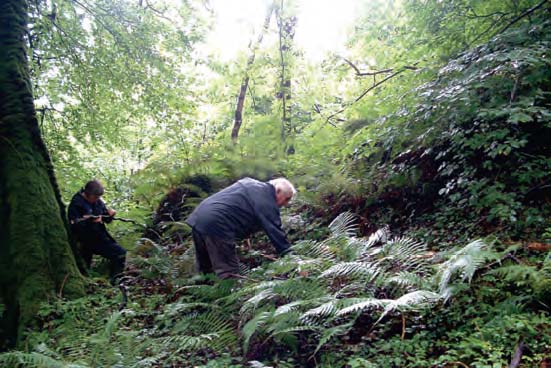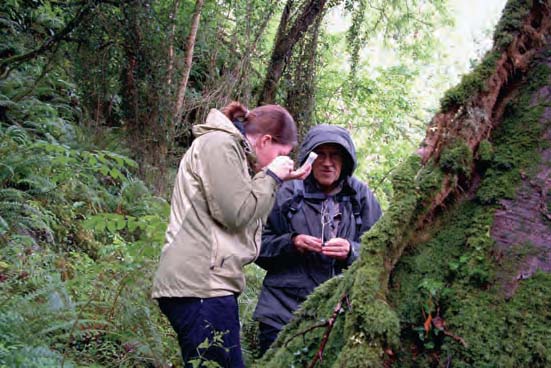|
Fermanagh was first suggested as a possible venue for a field meeting by Adrian Norris in November 2007. A considerable amount of time had passed since the Conchological Society last ventured to Irish shores, and since several members are resident in Ireland or have relatives there, this was quickly organised. What the organisers didn’t bargain on was the extremes of weather which were visited upon the emerald isle in August 2008! But that part of the story can wait until later. Accomodation was booked at Arch House (named after the famous Marble Arch Caves) just outside the gates to Florencecourt Demesne in south Fermanagh. Nine members duly arrived on Friday 15 August to the accompaniment of heavy rain. However, the lodgings were comfortable, the food excellent and the ‘craic’ enthusiastic – old friends and allies sharing reminiscences and looking forward to outings over the following two days. Surely it couldn’t rain as heavily as this through the night and into the next day? It did! and Saturday dawned drear and water-logged with gutters overflowing and floods everywhere. The party resolutely donned protective gear and headed out to the ash woods below Hanging Rock (H109364) about five miles along the road to Belcoo. The steep slopes were daunting, with waterlogged mud and litter, but only one member actually fell (no names!) and we made it up the main slope to some scattered beech trees among the ash. What was remarkable was the scarcity of slugs in this wood. Spring 2008 had been very dry, with no rain for nearly two months in Fermanagh. A general scarcity of tree slugs Lehmannia marginata had been noticeable to me across the county during the summer and it came as no surprise that we found only a single adult and no juveniles, something truly unusual in western Ireland. Adrian’s theory was that the rain was too heavy and the slugs would eventually come out once it stopped! However, we didn’t get an opportunity to test that hypothesis! The scarcity of slugs besides, there was a reasonable selection of molluscs, totalling 29, which included Arianta arbustorum, Balea heydeni, Cochlodina laminata, Leiostyla anglica, Limax cinereoniger and Zenobiella subrufescens. Arianta is rare and localised as well as confined to the north in Ireland (barring a possible introduction near Cork) while Cochlodina has a distribution which is centred on Fermanagh with scattered localities in Co Sligo and along the Shannon Lakes. The missing species were interesting. No Spermodea lamellata, although this is a site where it has been repeatedly recorded. Was the dry spring having another unforeseen effect? During the weekend we were able to find Spermodea only at two sites and commonly only at one of these. No Acicula fusca either, although found by others at Hanging Rock as recently as 2003 (Geraldine Holyoak, pers. comm.). For lunch we repaired to the nearby village of Belcoo. A really heavy belt of rain came in just as we set off. Happily this abated somewhat when we later drove into the hills behind Hanging Rock to visit Crossmurrin National Nature Reserve, or Marlbank as it is sometimes called (H110348), which has the only substantial piece of limestone pavement in Fermanagh. The reality of Crossmurrin is less interesting than this sugests, as the site comprises mostly acid wet grassland with a few bits of pavement and scarcely a vestige of the remarkable flora usually associated with this habitat. The mollusc fauna wasn’t to die for either. We totted up 16 species including Pyramidula pusilla and Vertigo substriata. The woodlice were arguably more interesting with a small colony of Armadillidium pulchellum discovered on top of an overgrown stone dyke (presumably striving to escape the flooding). On our way back to Arch House we stopped briefly at a marshy field with Iris (H108364) and collected numerous Arianta with a few Vertigo antivertigo and V. substriata.
The deluge eased to a drizzle on the Sunday and we headed, at the request of Barry Colville, to a known Succinella oblonga site. This was Gortaluchany Quarry (H169301) on the east side of Trien Mountain. A steep drive brought us up to a small abandoned quarry on limestone – a drier habitat apparently much appreciated by Succinella in this wet area. Barry was in his element and eventually found 32 Succinella on bare, slightly mossy rock and piled up branches on the quarry floor. A total of 22 species were recorded including Euconulus fulvus, Deroceras laeve and Pisidium personatum. Still fairly wet therefore, despite the abundance of bare rock. At this point Barry and wife elected to make for the ferry in Belfast as word had arrived of serious flooding to roads on the way back. Happily, despite several flood diversions and five wrong turns, they made it to the docks on time. In a rain-free interlude at this point Ian Killeen and Evelyn Moorkens felt buoyed up enough to head off to Donegal and continue some Vertigo geyeri work interrupted by the meeting. This left myself, Adrian Norris, Eugenie Regan, Stephen McCormack and Julian Nunn to continue on what turned out to be the most prolific period of the weekend. Our next stop was roadside scrub at Coolarkan (H118437), near the Boho Caves. This looked rather uninteresting and comprised a mixture of blackthorn, hawthorn and ash on the borders of a conifer planting. Only 11 species were recorded but included several Spermodea collected by Eugenie under hawthorn with a great abundance of Arianta on an overgrown roadside bank. From there we passed through Boho and turned west towards the famous cliffs at Knockmore. A roadside stop at a small flooded loughan called Lough Leen (H130454) was more productive than expected. I was tempted to try for freshwater molluscs in a flooded field next to the lake and came up with 15 species including Euconulus fulvus, Deroceras laeve and several Succinella oblonga by using a water net, but no freshwater species whatsoever! Meanwhile Adrian had pulled several Balea heydeni from moss on a roadside fence post. Balea heydeni is abundant in Fermanagh but, despite several searches in suitable places, there was no sign of its close relative Balea perversa on limestone dykes and walls. Balea heydeni lives mainly on lichenous trees and I can remember collecting hundreds from lichenous Sitka spruce on a hillside at Lough Navar just to the north of our current location.
We spent a short time on the flooded shores of Ross Lough (H144467) further up the Sillees River from Lough Leen. Seventeen species were recorded on the lakeshore including Cochlina laminata and Zenobiella subrufescens in mixed woods and Aplexa hypnorum, Anisus leucostoma, Succinea putris, Vertigo antivertigo and Vertigo pygmaea on the flooded margins of the lake. As the afternoon was drawing on, Julia decided to leave for Belfast which left four of us to soldier on. A last gallant attempt was made to find a diverse woodland fauna, this time on the sides of Carrickbeg Cliffs (H117467). Unfortunately the rain found us again and increased steadily in intensity. Before the trip was finally washed off, a small area of hazel and holly scrub below the cliffs paid dividends. The wood appeared unremarkable but so dense as to be almost impenetrable, even to sheep. This may have been its secret as the fauna was rich and diverse. Samples of leaf litter were taken for later analysis and together with the in-field catch came to the following totals for an area no greater than two square metres: Acanthinula aculeata (3); Acicula fusca (18); Arianta arbustorum (3); Carychium minimum (2); Carychium tridentatum (259); Cochlodina laminata (1); Columella aspera (15); Columella edentula (3); Euconulus fulvus (11); Lauria cylindracea (15); Leiostyla anglica (8); Punctum pygmaeum (16); Spermodea lamellata (207); Vitrea crystallina (7). All told, 30 species were recorded both in the wood and on rocks and grass nearby, despite the rain. One feature of the wood worth remarking was the high incidence of holly. Adrian had earlier confided a tip for finding Spermodea in difficult areas – look for the nearest holly and search underneath. As so it turned out. I had spotted some holly in the scrub and struggled through a dense hedgebank to reach it, only to find my way blocked by more dense undergrowth. Only two of us were able to get into what was a tiny open area within the scrub but, pulling litter from under holly produced large numbers of Spermodea on blackened holly leaves. In summary, the trip was something of a marathon water-fest but with a happy sting (or holly prickle) in the tail towards the end. Fermanagh has numerous lakes, indeed in some areas there is more water than land surface, but we were unable to sample any of this because of flooding. The total for the trip of 59 species was therefore fairly respectable. |
Figure 1: Adrian and Julia, Hanging Rock (Roy Anderson)
Figure 2: Eugenie and Barry, Hanging Rock (Roy Anderson)
Figure 3: Searching for Succinella at Gortaluchany Quarry (Evelyn Moorkens)
Figure 4: The group at Gortaluchany Quarry (Ann Colville)
Figure 5: A rare sight – Julia does non-marine! (Evelyn Moorkens)
Figure 6: Limax cinereoniger (Roy Anderson)
Figure 7: Spermodea lamellata(Roy Anderson)
Figure 8: Succinella oblonga (Roy Anderson)
Figure 9: A handful of Succinella oblonga(Evelyn Moorkens |
Field meeting - Fermanagh 16 & 17 August 2008
Issue
18
Page
12









